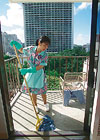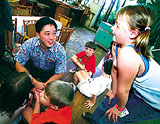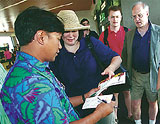Hoping to reap Waikiki’s rewards
Pam and Randin Yagi are starting to think about clothes and toys for the new baby. Billy Remular is planning a second honeymoon to tell his wife, Shirley, that, after 11 years, she’s still the one. Garfield Namahoe wants to send his daughter the karate champ to as many tournaments as possible. And Patti Nakagawa needs a bigger home, one with room for her aging parents.
But the plans of all these devoted O‘ahu tourism workers depend on whether a fresh, new Waikiki can deliver more visitors and prosperity.
In the coming year, Hawai‘i’s most famous resort area and the island that generates roughly half of the state’s $10 billion tourism economy is expected to wake from a long slumber and emerge as something new and more beautiful than before. A new bandstand already graces Kapi‘olani Park and the restored Natatorium War Memorial has gone from eyesore to attraction. Kuhio Beach sports a spiffy new police station, concession area and surfboard racks, and by September the city’s $13 million renovation project will have also widened the beach and added new amenities. By spring, luxury retailer DFS Hawai‘i will drop the mesh facade covering its Kalakaua Avenue store to reveal a 70,000-square-foot shoppers’ heaven, and the Hilton Hawaiian Village will unveil its state-of-the-art Kalia Tower, Waikiki’s first new commercial hotel project in a decade. By January, the resort’s center will become a “Business Improvement District,” with added security arrangements and landscaping provided by the area’s businesses.
Many are counting on the changes to pull Waikiki out of a decade-long spiral that culminated in 1998, the year a Neighbor Island, Maui, beat O‘ahu’s hotel occupancy numbers for the first time. It was the same year fewer people came to O‘ahu, and 8 percent more headed directly to the Neighbor Islands.
Waikiki remains one of the state’s best-known icons, with Diamond Head, surfers, lei vendors and outrigger canoes the images people worldwide conjure up when they hear the word “Hawai‘i.” It boasts one of the Islands’ most diverse nightlife and shopping scenes and is slowly building a reputation for business as each new group of conventioneers fills the Hawai‘i Convention Center at Waikiki’s edge. And despite its troubles, 70 percent of Hawai‘i’s nearly 7 million visitors still come to O‘ahu each year.
With roughly half of all of the state’s hotel rooms and 39,000 jobs, Waikiki produces nearly 18 percent of the gross state product, and what happens here ripples across the channels to all other islands. To keep it — and the state’s economy — healthy, tourism officials are looking for 2.7 percent growth in visitor days this year, the most aggressive target of all the islands because it represents the greatest increase in actual visitors.
To meet the targets, the O‘ahu Visitors Bureau will focus its $3.5 million budget on luring new first-time visitors from the eastern United States, and on reviving interest among Japanese travelers, who once made up roughly half of Waikiki’s visitors but in the past three years have discovered new destinations. Conventions are targeted to hit 40 a year by 2004, a goal the Hawai‘i Visitors and Convention Bureau will try to meet by spending $6 million a year on marketing through 2002.
So far, this year has clipped along nicely, with hotels filling more rooms nearly every month, and more visitors coming than expected. The more solid that trend, the closer the dreams of the Yagis, the Remulars, the Namahoes, the Nakagawas and the other people here who reflect the many faces of what may be Hawai‘i’s most-visited destination.
Pam Yagi
Hotel manager, ’Ohana Waikiki West
Married, 33, 6-year-old son Christian
 |
| “If we know we need to hit a certain number, we’re much more flexible with the rates. If they walk in, we may not charge them that $129 right off the bat.”
– Pam Yagi, hotel manager |
It’s a Monday in mid-June, and Pam Yagi is $2,000 off her budget numbers for the month, one of the slowest she has had since taking over the Ohana Waikiki West last August.
She tells her front desk staff to be aggressive about selling upgrades and pushes the hotel’s room rate down to $65 — as low as it can go — to lure stragglers to fill in the gaps.
“If we know we need to hit a certain number, we’re much more flexible with the rates,” says Pam, who notes that on a really slow day she’ll cut staff costs by getting behind the desk herself. “If they walk in, we may not charge them that $129 right off the bat. You feel the person out and see what they’re willing to pay.”
The property, with kitchenettes in 442 of its 663 rooms, caters to a more budget-oriented traveler and thrives on the attractiveness of its rates.
Making her bottom line each month affects everything from how many people Pam keeps on staff each day, to how much she’ll charge a walk-up guest, to how many dollars will be in her year-end bonus package, which determines how many gifts her 6-year-old son, Christian, will find under the Christmas tree, and how many clothes she will buy for the family’s newest child, due in January.
“What a time to have a baby — January!” says the still-slim manager, who is fretting about taking time off during peak visitor season. “My immediate goal right now is to get my guest services manager trained, because once I go on maternity (leave), I won’t be here for six weeks, and she’s very new to the property.”
With her bonus, which depends on the hotel’s performance, Pam makes between $40,000 and $50,000 a year, a similar amount to her husband, Randin, who is in business sales at Kraft Foods. Together, they have created a comfortable life for their family, with a townhome in Kapolei and regular vacations, such as the five days they spent in April at the Outrigger Waikoloa Beach Resort, a sister property on the Big Island.
Managing home and family means juggling a $1,700-a-month mortgage and a $300 monthly payment for Pam’s 1996 Honda Accord. Afterschool care for Christian comes in at $350 a month, and goes up to $625 in the summer, when he adds a computer class to his schedule. New school clothes each August run about $300.
And of course, there are groceries to buy, which average just under $100 a week, but Christian — and Randin’s golf habit, Pam jokes — eats up most of the couple’s disposable income.
Both Yagis are avid savers, and Pam estimates she alone has socked away just under $60,000 in her 401(k), which she maxes out at 15 percent of every paycheck. But in the coming months, the family budget will have to make way for the new little person, who will need all manner of things from clothes to a crib to a stroller.
“If any big purchases are to come it’s baby stuff,” she says. “We gave everything away. We had donated it in the last year, because we said, ‘OK, no hope, forget it, let’s just give it away.’”
“I don’t plan on buying anything majorly special or big,” she says. “Just the necessities.”
Florencia Daga
Housekeeper, Waikiki Beachcomber Hotel
41, from Batac, Philippines
 |
| Florencia Daga of Kalihi cleans a lanai at the Waikiki Beachcomber Hotel. Workers depend on Waikiki’s prosperity. |
Since Florencia Daga came to Hawai‘i from her hometown of Batac in the Philippines five years ago she has cleaned rooms at the Waikiki Beachcomber Hotel, spending enough from her wages to enjoy life, but always saving for her dream of returning to the Philippines some day.
“I like to save money, then go settle to the Philippines because it’s better out there,” she says. “It’s poorer, but it’s always good to be back in your own country.”
The enthusiastic housekeeper shares a home in Kalihi with her mother, her boyfriend, Edwin, who also cleans rooms at the Beachcomber, and five sisters and brothers, all but one of whom work as housekeepers and cooks in Waikiki hotels. The home is owned by her sister Elizabeth, who came to Hawai‘i in 1977. Elizabeth and Florencia’s other brothers and sisters hold senior positions at their jobs, ensuring they work a full schedule even when business is slow.
But as a less-senior employee, Florencia can go two weeks without work when there aren’t any visitors to dirty up the rooms, as she did in May 1999, when Oahu hotel occupancy rates dipped to 64 percent. She’s hoping this busy summer season will bring a steady stream of visitors — and hopefully higher-spending and better-tipping ones — to keep her savings going.
“The Japanese, mostly they give tips,” she says. “Some haoles, yeah, they give, but not really very often times, but more — if they give, it’s like $5, $10, $20. But the Japanese every day they give, but it’s only one dollar per bed, sometimes $2.”
From each $600 paycheck, which comes twice a month, Florencia has the credit union automatically deduct $100 and place it in her savings. She figures $50,000 ought to be enough to retire to the Philippines, provided she remains thrifty when she gets there. So far, she says, she’s got about $2,000 in the account, which was recently depleted by the purchase of a “slightly used” Toyota 4 Runner and an investment of $10,500 in a friend’s mineral water business back home (for which she says she borrowed about $4,000 through the credit union).
After she and Edwin pay the bills — $500 for rent, up to $180 for phone calls, a scattered amount on the car and investment loans — Florencia always finds $50 or more to send home, where she is sponsoring her 19-year-old niece, Preslyn, a physical-therapy student at the university in the city of Laoag. “We Filipinos, we have our relatives back in the Philippines!” she jokes.
For Christmas, Florencia is hoping she and her family will be able to save enough to help some cousins from London and Canada and a sister from Colorado come visit. And for herself, before she returns to the Philippines someday, she would really like to see Las Vegas.
“Everybody is saying ‘It’s fun! It’s fun!’” she says.
Bert Momotomi
Director of guest services, Hilton Hawaiian Village
30, single, aspiring homeowner
 |
| Bert Momotomi, director of guest services at the Hilton Hawaiian Village in Waikiki, chats with children participating in the hotel’s Rainbow Express program. |
A crying toddler wanders past Bert Momotomi, breaking his train of thought as he talks with a visitor in a lobby at the Hilton Hawaiian Village.
“Is she lost?” he says mostly to himself as he moves toward her. Within seconds, a bemused mother reclaims the child from the kneeling Bert, who returns to his conversation.
“That’s basically my job, right there,” he says.
As director of guest services at one of Waikiki’s landmark hotels, Bert oversees 19 full-time assistant managers, concierges and children’s program leaders, all with the basic goal of making sure every hotel guest gets the highest level of attention.
When the Hilton’s new 453-room Kalia Tower opens in the spring, that job will get harder, he says, and will likely require him to increase his staff. If statewide efforts to attract higher-spending visitors succeed, Bert’s task will become even more difficult.
“The more they pay, the more they expect from the hotel,” he says. “Even more so with the Japanese customers. There you’re waited on hand and foot.”
If more visitors begin flooding the island, Bert’s employees are likely to get more hours. On this especially clear June day, the 2,545-room Hawaiian Village is 100 percent full; Bert has two assistant managers working instead of one, and three concierges instead of two. He has also called in two part-time people to lead children’s groups.
Calling in extras has not been unusual so far this year, Bert says, when hotel room rates and occupancy island-wide have topped last year’s nearly every month through June. Throughout the summer, he says, he expects to have at least eight people a day working the children’s program.
“A lot of the on-call people are getting a lot of hours,” he says.
Single, Bert lives in the guest house on his parents’ property in Wahiawa. With a manager’s salary and few monthly expenses, he has a great deal of disposable income.
He gets a “family rate” on the rent, which ranges from $200 to $400 a month, depending on his inclination, he says. His 1998 Toyota 4 Runner was paid for with savings from eight years at tour wholesaler Japan Travel Bureau while he attended the School of Travel Industry Management at the University of Hawai‘i. He has no loans and no debt, he says, and basically pours money into a bank account with which he hopes to buy a house sometime in the next couple of years.
The rest of his money finds its way mostly to concerts and movies, world travel and, occasionally, golf.
He is considering vacationing in Tokyo in October, a trip he expects would run about $2,500.
“I can speak Japanese fluently, but I’ve only been there once,” he says. “I do have family there on my mother’s side. But basically it would be something for me to enjoy.”
Billy Remular
Customer service agent, Aloha Airlines
37, married, five children
 |
| Billy Remular, a customer service agent with Aloha Airlines, collects boarding passes from passengers bound for Hilo. |
Billy Remular is a family man. A day with his kids is as good as it gets, and if they can all bodyboard, camp and take a few trips together this year, life will be all right.
“We like to stress family, and we do a lot of barbecues at the beach,” he says. “Every weekend we have the ‘ohana come and potluck with us.”
The Aloha Airlines customer service agent says he expects to work as much as 16 hours a month overtime between June and mid-August. The couple of hundred dollars in extra cash each month could go toward a second honeymoon on Kaua‘i with his wife, Shirley, or toward a family vacation to Las Vegas or Disneyland. Or maybe just toward the bills.
“With five kids, you accumulate bills,” he says.
When they married 11 years ago, Billy became stepfather to Shirley’s four children, two of whom still live at home with them. They have one of their own together, 10-year-old Liane, a keiki bodyboarding champ who most weekends keeps the family hanging around Walls, Waikiki’s best boarding spot.
“She’s like my pride and joy,” Billy says. “Her mom’s proud of her, too.”
Shirley teaches special education at Kahala Elementary School. With Billy’s nearly $18 an hour at Aloha, where he has won the company’s outstanding service award a record three years in a row, they have made a comfortable life for their family. But to give them more wiggle room, Billy always works a second job, teaching Hawaiian studies at Pearl City Elementary School four mornings a week during the school year, and teaching swimming to children and babies at the Leahi Swim School in Manoa during summer.
“In Hawai‘i, you have to work two jobs if you want to live comfortably,” he says.
Draining the pot is $1,125 in rent for their three-bedroom townhouse in Pearlridge, plus payments on a few thousand dollars in loans for their 1997 Honda station wagon. Night school tuition for Shirley, who is working toward an associate degree in early childhood learning at Honolulu Community College, gets its share. And then there are proms and school trips, Billy says. With young adults such as 16-year-old Jonah and 21-year-old Shelley at home, costs add up.
But there is always money for fun, Billy says, such as the first birthday barbecue for his grandson Noah Kealaka‘i, who came with his mom and dad from North Carolina for the event early in the summer. Billy hopes there will be enough money to take the family on a Mainland vacation this year, but if not, he says, they can always find their place in the surf.
“It’s an ultimate thing when the whole family’s on one wave in Waikiki with Diamond Head in the back,” he says.